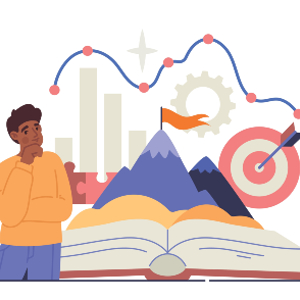
Imagine you’re in a meeting and the analytics team bombards you with numbers. Sales have dropped by X%. Ad spend has increased by Y%. Cost-per-click is now Z. The meeting ends, and you promptly forget everything. What if the analytics team had instead turned those raw numbers into a memorable narrative? That’s the idea behind storytelling with data.
Data storytelling allows you to create a powerful narrative that helps everyone understand and remember insights. In this article, we will explore the art of storytelling with data and how it can be done.
What Is Storytelling with Data?
Data storytelling is the practice of transforming raw data into a narrative that communicates insights, patterns, and trends in a clear and compelling manner. It uses data visualization techniques, such as charts, graphs, and infographics, to illustrate key points and support the narrative’s message. But data storytelling goes beyond just presenting facts and figures. It also contextualizes data and uses visualization software, making it relatable and memorable for the audience.
Elements of Data Storytelling
- Context: As with any other kind of storytelling, context matters most. For example, if you read in the news that the stock market crashed, wouldn’t you be curious why? Similarly, when you are working with your business numbers, you need to know the why. Was there a jump in your traffic? Why? Maybe there was a Google update, or maybe all your content marketing strategies are finally working.
- Visualization: The next element that can make or break your data story is visualization. What sort of elements will you display those numbers with? Will a bar chart work or maybe a pie chart? It’s important to choose the most appropriate visualization type for the specific data you’re working with, considering factors like the data’s nature (e.g., numerical, categorical), the story you want to tell, and your target audience. Think of a weather report that uses colorful maps with temperature gradients to show a heatwave approaching a region.
- Narrative structure: Like any good story, a data story should follow a narrative structure. It should have a beginning, middle, and end. The beginning should introduce the data and set the stage by establishing the problem or context. The middle should focus on analysis, insights, or trends. Finally, the end should summarize the message and possibly suggest actions or implications based on the data.
- Emphasis on key insights: In a data story, you need to choose which data points are worth mentioning. Effective data storytelling involves emphasizing the most critical insights or findings, ensuring they are easily discernible to the audience. You may use visual cues, such as color, size, or position, to draw attention to key elements in the data. At a basketball game, scores are displayed prominently on large screens. Similarly, you need to highlight your key insights in a data story.
Tools for Storytelling with Data
Now that you know what data storytelling is and how you can use it, it’s important to understand what tools you should have for a successful data storytelling session. In addition to data visualization tools, these supporting tools can help you tell your data story:
- Data extraction tool: A data extraction tool will make your life easier by extracting relevant data from structured and unstructured sources. Whether it is PDF files, images, or handwritten notes, you can use this tool to get data.
- ETL tool: An ETL tool will help you cleanse and transform your data so that it is ready for analysis. ETL tools of today come with various built-in sources and destinations, which make it easier to transfer data from their sources to their destination.
- Data warehousing tool: You can easily transfer data to a visualization tool. However, a data warehouse will help you centralize your data in one place and build relationships, which will in turn help provide context for your data story.
Avoid Common Data Storytelling Pitfalls
Not all stories are interesting enough to keep you hooked. Similarly, a data story can fail to be compelling. Here are some common mistakes that you should avoid while telling a data story:
- Poor data quality: A trustworthy data story requires high-quality data. Use a data quality tool to ensure your data is clean and consistent.
- Confusing correlation with causation: There is a difference between exploratory and explanatory data. Exploratory data discovers patterns and relationships and explanatory data on the other hand tries to explain the reasons.
- Overloading with data: When you include an excessive amount of data, charts, or graphs in your presentation, it can overwhelm your audience. People have limited cognitive capacity to process information, and bombarding them with too much data can lead to cognitive overload. As a result, they may become disengaged, confused, or even lose interest in your story.
- Cherry-picking data: This often happens because of confirmation bias, where you seek out and prioritize information that confirms your preexisting beliefs or desired conclusions. It can lead to a one-sided, skewed perspective on the data.
Conclusion
Data storytelling can be a very important tool in presentations. With the right tools and data sets, storytelling can help you achieve your business goals, from pitching your idea to a stakeholder to getting funding for your next marketing campaign.
Image used under license from Shutterstock.com
